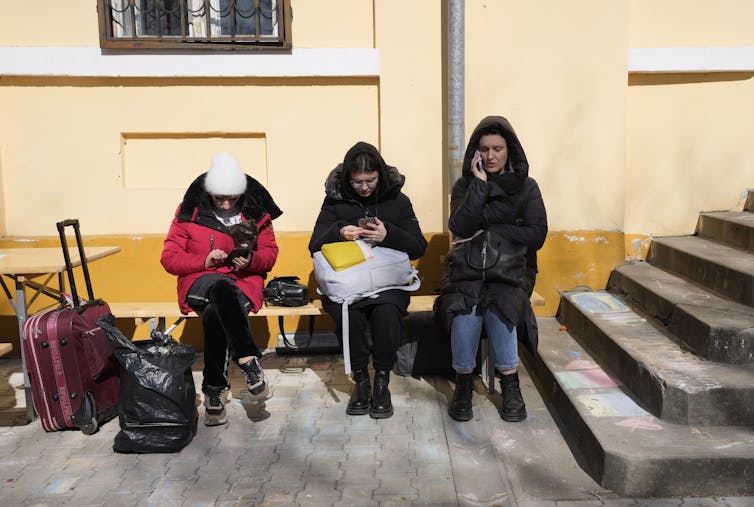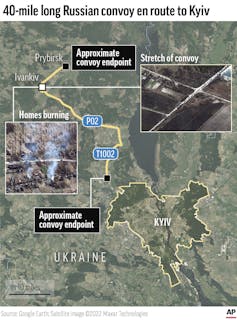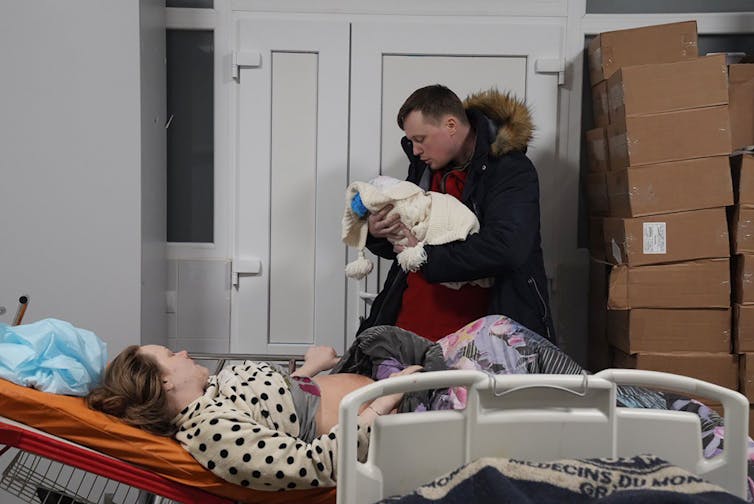
Katharina Niemeyer, Université du Québec à Montréal (UQAM); Dominique Trudel, Audencia; Heidi J. S. Tworek, University of British Columbia; Maria Silina, Université du Québec à Montréal (UQAM), and Svitlana Matviyenko, Simon Fraser University
Since Russia invaded Ukraine, we keep hearing that this war is like no other; because Ukrainians have cellphones and access to social media platforms, the traditional control of information and propaganda cannot work and people are able to see through the fog of war.
As communications scholars and historians, it is important to add nuance to such claims. The question is not so much what is “new” in this war, but rather to understand its specific media dynamics. One important facet of this war is the interplay between old and new media — the many loops that go from Twitter to television to TikTok, and back and forth.
We have moved away from a relatively static communication model, where journalists report on the news within predetermined constraints and formats, to intense fragmentation and even participation. Information about the war becomes content, and users contribute to its circulation by sharing and commenting online.
Modern warfare and media
Modern warfare and media technologies have a long and complex history. During the First World War, airplanes served both as weapons and media by taking aerial photographs and drop propaganda pamphlets over enemy lines. Soldiers commonly used their personal cameras in the first months of the war before their political and military leaders prohibited such practices and put them in the hands of specialists.
During the Second World War, each division of the German army had its own team of cinematographers filming the war. In 1943, when the army lacked resources, thousands of soldiers participated in the filming of Kolberg, a 1945 propaganda movie meant to boost German morale.
The Vietnam War is often presented as the first “uncensored” war, as media scholar Daniel Hallin put it. During the Gulf War in 1991, the 24-hour coverage by cable news channels conveyed a different impression of war. Confronted by the neat videos images furnished by the military, journalists soon referred to it as the “Nintendo War.” Since then, the implication of media in war has increased in speed and fragmentation.
The development of cyberwar

Cyberwar is a key component of the current war. It refers to all operations taking place on the internet, and to the physical infrastructure that supports it. This includes network disruptions, website jamming, and so on.
Cyberwar occurs alongside classic media censorship, and includes the accelerated distribution of information. It comprises complex communication events between people and machines, and can be intentional, coordinated and deliberate — or not.
Cyberwar in Ukraine occurs at different scales. Drones can capture enormous data sets for analysis by artificial intelligence, and use that for precision targeting. This includes pinpointing the location of soldiers or civilians by heat maps, digital signals or social media posts.
Many historical propaganda techniques extend into cyberspace, but an emerging new extension is the means to target and personalize disinformation. Aggressive military propaganda techniques combine with tools for online marketing.
The ability to identify soldiers and their family members means that actual or fake threats can be made to persuade people to surrender. This strategy also includes circulating an insidious deepfake video of the Ukrainian president Volodymyr Zelensky asking the Ukrainian people to surrender to the Russians.
Censorship in Russia
All official TV channels in Russia (TV1, Russia, Zvezda) have only been broadcasting their version of events: there is no war led by Russia, only a special operation. The Russian government focused on an unprecedented disinformation campaign targeting its own population, and muzzling independent media that had been already persecuted as so-called “foreign agents.”
A few days after the beginning of the invasion, the Kremlin passed the War Censorship Law to “prohibit the dissemination of fake news about the special operation” as well as use of words such as “war” (voina) and “invasion” (vtorzhenie) — offences are punishable by up to 15 years in prison.
Official Russian television is broadcasting images of the Russian military as “liberating” Ukraine from “neo-Nazis and drug addicts.”
Russian television misleads the audience by extensively using fakes and triggering panic by referencing nuclear contamination. The audience is told that Ukrainians are causing all damage to themselves.
Staged scenes are used to create a desirable image of Russian “liberators.” One of them shows a welcoming crowd of Ukrainians in Kherson, happy to meet Russian troops and receive generous humanitarian aid. However, as a friend in Ukraine wrote to one of us on Telegram, after filming, the Russian army took this aid from the citizens and moved on.
Finally, Russian television uses “denazification” in an attempt to justify their special operation in Ukraine to Russian audiences. This is intended to evoke a regressive nostalgia for the victory over Nazi Germany, and has been part of Putin’s historical distortions for several years now.
The international state propaganda channel RT (formerly Russia Today) is now banned in Europe and Canada.
Battle for truth
On March 9, a maternity hospital in the Ukrainian port of Mariupol was heavily shelled. The hospital’s infrastructure was destroyed, and at least three people were killed and 17 injured. President Zelensky condemned the attack, referring to it as “ultimate evidence that genocide of Ukrainians is happening.”
Official Russian television claimed that the hospital was empty weeks before, and that the devastating photos of the destroyed site contained many inconsistencies.

One of the photos of the hospital bombing showed a pregnant and injured young woman who was recognized as a local Instagram model. Hundreds of internet trolls immediately accused her of being a paid model to create fake news about the bombed hospital.
Accusations of fakery, propaganda and censorship have always been part of war, but cyberwar includes additional complexities. The intensive and fast dissemination of both fake and real information, the amounts and types of data collected, and the extensive and real-time documentation of events reveal the integration of information and communication into all aspects of war.![]()
Katharina Niemeyer, Professor at the Media School, Université du Québec à Montréal (UQAM); Dominique Trudel, Associate Professor, Communication, culture and languages, Audencia; Heidi J. S. Tworek, Assistant Professor of International History, University of British Columbia; Maria Silina, Adjunct professor, History, Université du Québec à Montréal (UQAM), and Svitlana Matviyenko, Assistant Professor, Critical Media Analysis, Simon Fraser University
This article is republished from The Conversation under a Creative Commons license. Read the original article.

